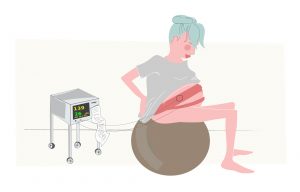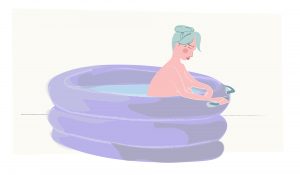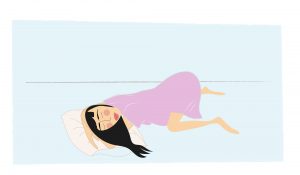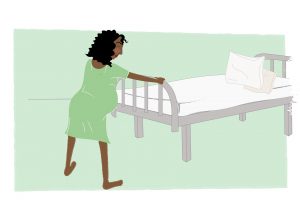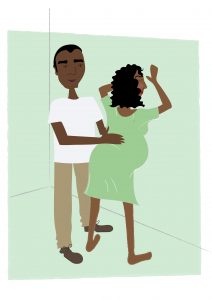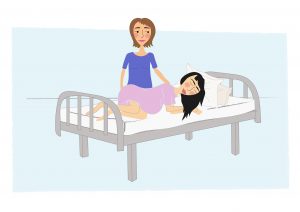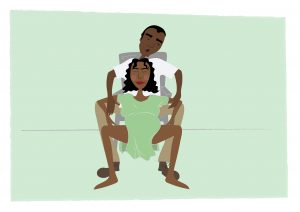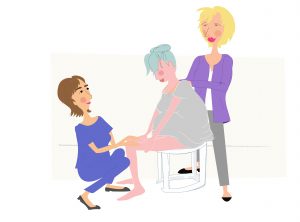Research shows interventions such as instrumental births and caesarean sections are more likely to occur if women are laid back on a bed during labour. This is one of the reasons the Royal College of Midwives (RCM) advises midwives to encourage women to remain active in labour and birth. It can also reduce the length of the first stage of labour by up to an hour and reduce the need for an epidural.
“Gravity is our greatest aid in giving birth, but for historical and cultural reasons (now obsolete) in this society we make women give birth on their backs. We need to help women understand and practise alternative positions antenatally, feel free to be mobile and try different positions during labour and birth. Once she is comfortable, try not to move her unless she wants to, or unless the position becomes inadvisable for maternal or fetal (and not organisational!) reasons.” RCM.
Balancing on the birthing ball
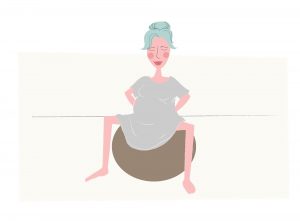
A birthing ball is a great way to take the weight off your legs but still remain active during labour. Whilst allowing you to move, it also helps gravity do its thing. Plus, if you get bored with sitting on it, you can lean on your birthing ball from a kneeling position on the floor.
Tip: Get used to your birthing ball at home before going into labour, so that you feel comfortable and safe.
Tip: Make sure you choose a birthing ball that is the right size for you. Your knees should be below your hips when sat on the ball, helping your baby stay in a good position for birth.
Sitting on the ball with a monitor – having your baby continuously monitored doesn’t stop you from being able to stay active. You can use the birthing ball in exactly the same way as mentioned above.
Hydrotherapy and birthing pools
Warm water is a gentle and soothing labour option, that gives you a sense of weightlessness. It is a safe and effective non-pharmaceutical form of pain relief. You can adopt many different positions in a birthing pool, including:
- Squatting using the side of the pool for support
- Kneeling against the side of the pool for support
- Floating on your back
- Sitting
Plus, your partner can join you in the pool if you’d like the extra support.
Kneeling down
A kneeling position allows gravity to help your labour to progress normally, whilst encouraging your baby into a good position for the birth. It also takes the weight off your legs when you’re getting tired of standing or squatting. You can kneel and lean over the back of the bed, over a birthing ball or even into your birth partners lap.
Leaning against the bed
The bed is a great piece of equipment to lean against when adopting standing positions. A hospital bed can be raised high into the air to make it a comfortable height that best suits you. If your baby is being monitored, this is a great alternative to sitting or lying on the bed.
Standing
Standing upright relieves labour discomfort. It opens up your pelvis and gravity helps your baby to move down into your birth canal. Standing is a position you can adopt in any stage of labour. It’s a good position for rocking, which relieves pain and moves your pelvis to encourage your baby to descend.
Leaning against something
Leaning against a wall, or your birthing partner, when standing, gives you the support you’re likely to need when your contractions are increasing in intensity and becoming more regular. It’s a great position to receive a massage too!
Lying down in bed
If you choose to lie down on the bed, it is always best to lie on your side rather than on your back. This is because it doesn’t compress any of the major veins in your back, which would reduce the oxygen supply to your baby, and make you feel light-headed. Lying on your side is a good position for when you need to rest and recuperate some energy during labour. Plus, if you’ve had an epidural and find it difficult to adopt more upright positions it’s a great way of keeping your baby in a good position for birth and will help you avoid the semi-recumbent sitting position.
On all fours
An all fours position is a great position, particularly if your baby is back-to-back, as it allows you to do pelvic tilts, which help to ease pain and help your baby turn. This position can be adopted over the back of a bed, over a ball, on mats and it can be used if your baby needs to be continuously monitored.
Being supported in a squatting position
This is a great position for pushing as it opens your pelvis up and allows gravity to help in moving your baby down. It’s also a good position for getting your partner involved, as they can support you from behind for comfort.
Using a birthing stool
The birthing stool helps take the weight off your legs when you are in the squatting position, then the benefits are the same as being in a squatting position.
Tip: Some obstetric units also have birthing stools, so if you’re interested in using one, make sure you ask.
Content Disclaimer
The information contained above is provided for information purposes only. The contents of this article are not intended to amount to advice, and you should not rely on any of the contents of this article. Professional advice should be obtained before taking or refraining from taking any action as a result of the contents of this article. New Life Classes disclaims all liability and responsibility arising from any reliance placed on any of the contents of this article.


